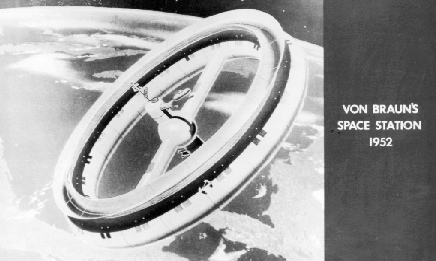
|
Credit & Copyright: MSFC Historical Archives
Explanation:
Orbiting 1,075 miles above the Earth, a 250 foot wide, inflated, reinforced
nylon "wheel" was
conceived in the early 1950s to function as a navigational
aid, meteorological station, military platform, and way
station for space exploration by
rocket pioneer Wernher von Braun.
The wheel shaped station could be easily rotated
creating artificial gravity so that the
astronauts would not suffer the effects of prolonged weightlessness.
Von Braun and his team favored building a
permanently occupied Earth orbiting space station from which to stage
a lunar exploration program.
But in the 1960s NASA adopted
the Apollo Program, which called
for astronauts to transfer to a lunar landing vehicle after achieving
lunar orbit, bypassing the construction of von Braun's wheel.
Information:
The
Scale of the Universe Debate in April 1996
|
January February March April May June July August September October November December |
| ||||||||||||||||||||||||||||||||||||||||||||||||
NASA Web Site Statements, Warnings, and Disclaimers
NASA Official: Jay Norris. Specific rights apply.
A service of: LHEA at NASA / GSFC
& Michigan Tech. U.
Based on Astronomy Picture
Of the Day
